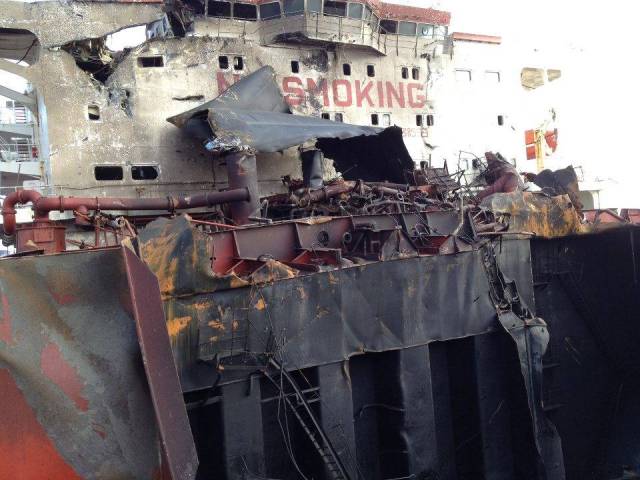The 29th publication of Ship-breaking.com is available (64 pages – 5,2 Mo)
This quarterly publication is an information bulletin and analysis on the demolition of vessels, Ship-breaking.com is read by thousands of specialists across the globe. The letters to the editor section point to the fact that the international public of Ship-breaking.com increases year after year.
The first edition of Ship-breaking.com was published in February 2006 in order for Robin des Bois to better understand the lifecycle of commercial ships and military vessels following the Clemenceau aircraft carrier affair. On this subject Ship-breaking.com has shown that exporting military vessels to Asia for demolition seems to be fixed in stone. Ship-breaking.com n°29 underlines this with the examples of the Russian cruiser Murmansk and the British frigate HMS Plymouth.
Ship-breaking.com n°29 elaborates on the topic of vessels which have been involved in an accident and their demolition on the spot, in the Mediterranean Sea with the Costa Concordia but also the Arctic, the Indian, the Atlantic and the Pacific Oceans. New information on the MSC Flaminia fire is included and as with most of Robin des Bois’ investigations historical, unknown or exclusive information is published. The END highlights the fatal accident which occurred on the tanker Prem Divya off the coast of Fujairah in the United Arab Emirates and her demolition on Gadani beach, Pakistan.
The 29th edition explores the small world of container ships, slaves to globalisation, of which many are idle and their owners are hesitating between waiting for business to pick up or to send them to be scrapped. Container ships are more and more gigantic. They are sent to be demolished at a younger age.
The 29th edition looks at the Lepse, which receives the award of the oldest vessel named, as well as, the most dangerous due to her radioactive cargo reaching Chernobyl proportions. The Lepse is Russian.
Between July 16 and October 14, 287 vessels have been scrapped, the 29th edition confirms the Indian and Bangladeshi lead in the market. These market leaders are regularly subject to legal red tape and fatal accidents. The last of which occurred at Alang on the Union Brave, a tanker built in Portugal and managed by an English ship-owner. The accident resulted in the conviction of the three shipyard owners and the temporary suspension of all activities which had been decided by the Indian Union of ship-breakers. The shipyard owners denied any wrongdoing or liability in connection with the accident.
Out of the 287 vessels leaving to be scrapped of which a large majority are being sent to Asia, 103 (36%) belong to European owners. This mirrors the trend already pointed at in earlier editions. Not one of these vessels underwent a preliminary removal of dangerous material such as asbestos, PCBs or used fuel.
Despite the successive renaming of vessels, Ship-breaking.com investigative reporters continue to identify and unearth vessels which became famous due to major polluting incidents. In the 29th edition the case of the Hebei Spirit is put forward. She arrived in Bangladesh under the name Gloria 21.
At the end of the first year of Ship-breaking.com, 2006, a total of 293 vessels were listed as leaving the waters to be demolished. Six years later, the yearly rhythm has broken the thousand threshold. This increase has not stopped Ship-breaking.com reporters from meticulously broadening the information bulletins with historical information and a selection of photos such as that of the Costa Allegra on which an accident occurred in February 2012 in the Indian Ocean from where she was towed to Genoa, had her chimney repainted white to avoid the syndrome of the yellow chimney and C notorious since the Costa Concordia wreck, and then recently sent to be demolished in Turkey.
 Prem Divya, December 29, 2011 : No smoking, welding OK © Cargolaw
Prem Divya, December 29, 2011 : No smoking, welding OK © Cargolaw
Ship-breaking.com # 29, 64 pages – 5,2 Mo
 Imprimer cet article
Imprimer cet article









